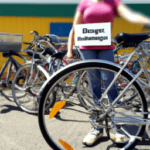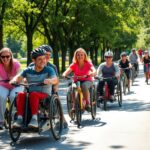To get involved in local cycling advocacy, start by engaging with your community early and often through accessible meetings, events, and outreach efforts. Connect with local advocacy groups like Bike Walk Connecticut or the League of American Bicyclists, and collaborate on campaigns or projects. Support policies that prioritize safety and infrastructure. Use local data to identify needs and empower youth and neighborhood leaders to champion cycling initiatives. Keep exploring to discover more ways to make a difference.
Key Takeaways
- Join local cycling advocacy groups and attend meetings to stay informed and contribute to planning efforts.
- Participate in community outreach events like Open Streets to promote cycling and connect with residents.
- Advocate for safer, connected infrastructure through town halls, bike audits, and engaging with policymakers.
- Use local data and safety reports to support initiatives and demonstrate the need for improved cycling facilities.
- Volunteer with youth programs and neighborhood groups to foster leadership and build a strong cycling community.
Building Community Trust and Engagement
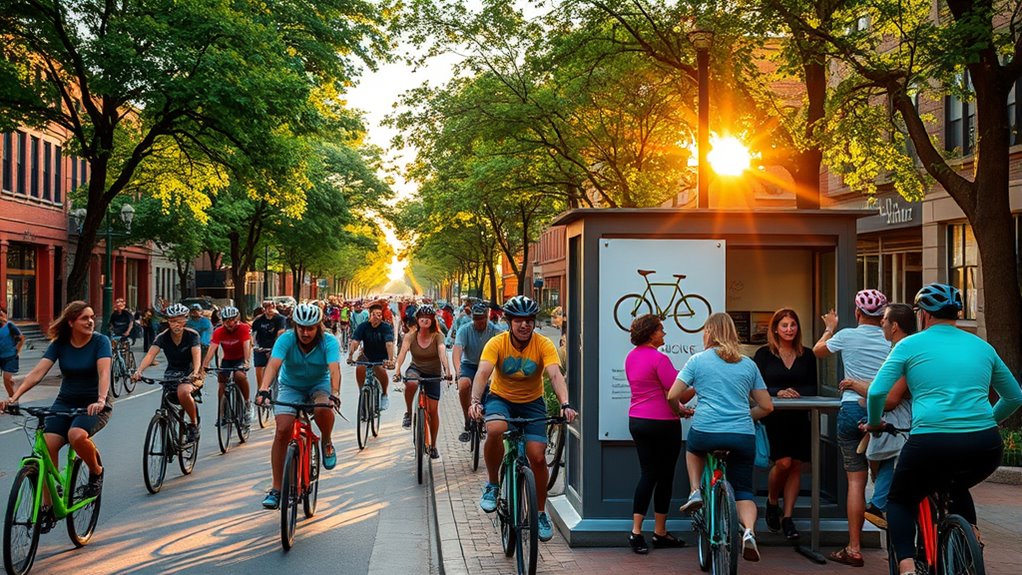
Building community trust and engagement is essential for successful cycling advocacy. You should start engaging early and often to create ongoing dialogue within your community. Use creative events like Open Streets to actively involve residents and make them feel part of the process.
Building trust early and often fosters lasting community support for cycling initiatives.
It’s crucial that the first time community members hear about bike projects isn’t right before implementation—build trust by sharing plans well in advance. Make meetings accessible to everyone, ensuring inclusivity. Incorporating community involvement strategies such as neighborhood outreach and local partnerships can further strengthen trust and participation. Additionally, understanding and addressing concerns about project sustainability can help reassure community members and foster ongoing support. Recognizing the importance of authenticity in communication can also help deepen community bonds.
Fostering visual clarity through transparent communication helps to clarify project details and dispel misconceptions, which is vital for long-term trust. Building trust takes time, but it’s the foundation for lasting support and successful advocacy efforts. Incorporating community-driven strategies, such as engaging residents through creative outreach methods, can further strengthen trust and participation.
Connecting With Local Advocacy Groups and Organizations

Connecting with local advocacy groups and organizations is a vital step in strengthening your cycling initiatives. Start by exploring resources like the League of American Bicyclists’ Bicycle Friendly America Program, which connects you to community, business, and university reviewers. Check out statewide directories to find groups like Bike Walk Connecticut or New Mexico cycling advocates. Collaborate with the Adventure Cycling Association on touring and route projects or join PeopleForBikes to stay updated on local ballot measures and funding campaigns. Use online tools such as the League’s local resources map or APBP’s directory to identify nearby groups. Engage through social media, subscribe to newsletters, and attend workshops to build your network and deepen your involvement in advocacy efforts. Incorporating community engagement strategies can significantly enhance the success of your initiatives. Additionally, understanding how to leverage website traffic techniques, such as social media marketing and content sharing, can help raise awareness and rally support for cycling projects. Recognizing the importance of public safety measures, like proper signage and infrastructure, also plays a crucial role in advocacy success. Moreover, staying informed about predictive modeling in educational data mining can help you anticipate community needs and tailor your outreach efforts accordingly.
Influencing Policy and Infrastructure Development
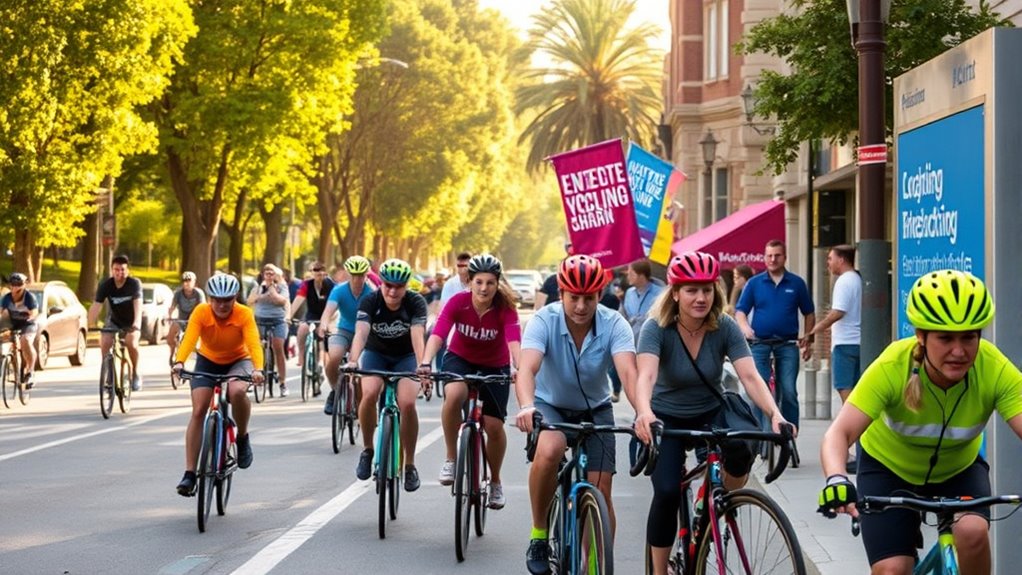
Have you considered how your advocacy can shape transportation policies and infrastructure? By lobbying for Complete Streets mandates, you guarantee roads are designed with cyclists in mind, including safe intersections and dedicated bike lanes.
Engaging in climate legislation can position bike infrastructure as a key carbon-reduction tool, opening funding. Promoting local funding mechanisms, like dedicated bike budgets or tax initiatives, directly supports infrastructure growth.
Advocating for reduced speed limits and safer road designs prioritizes cyclist safety. Pushing for bike-friendly policies in zoning and planning documents assures better connectivity and amenities.
You can also support campaigns that focus on network connectivity, low-stress routes, and climate resilience projects. Mobilizing community members through town halls, bike audits, and education programs amplifies your voice, helping to make cycling safer and more accessible for everyone. Additionally, understanding Private Placement Equity Markets can provide insights into funding opportunities for innovative transportation infrastructure projects.
Using Data to Support Cycling Initiatives
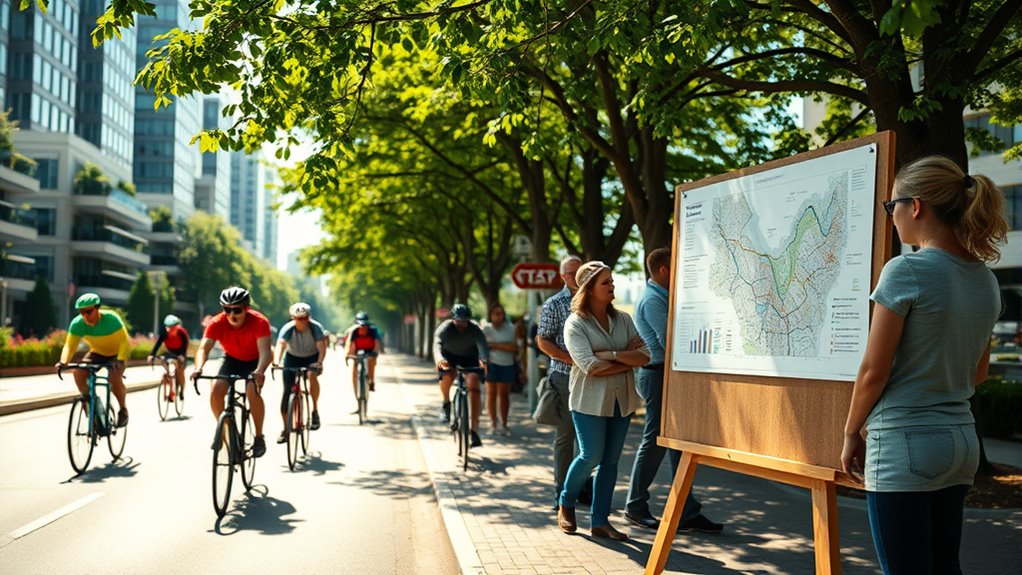
How can you effectively support cycling initiatives? By using data to build a strong case. Start with benchmarking data from the League of American Bicyclists to understand national trends and identify gaps locally.
Conduct surveys and partner with community groups to gather detailed insights into safety concerns and infrastructure needs.
Analyzing traffic accident reports helps pinpoint high-risk areas, while demographic and Census data reveal underrepresented populations and shifting patterns.
Use this information to craft targeted campaigns, safety initiatives, and policy briefs.
Present compelling data to local officials and media to raise awareness and garner support.
Collaborate with businesses and agencies, sharing data-driven insights to push for safer, more bike-friendly environments that meet your community’s specific needs.
Empowering Youth and Neighborhood Leaders
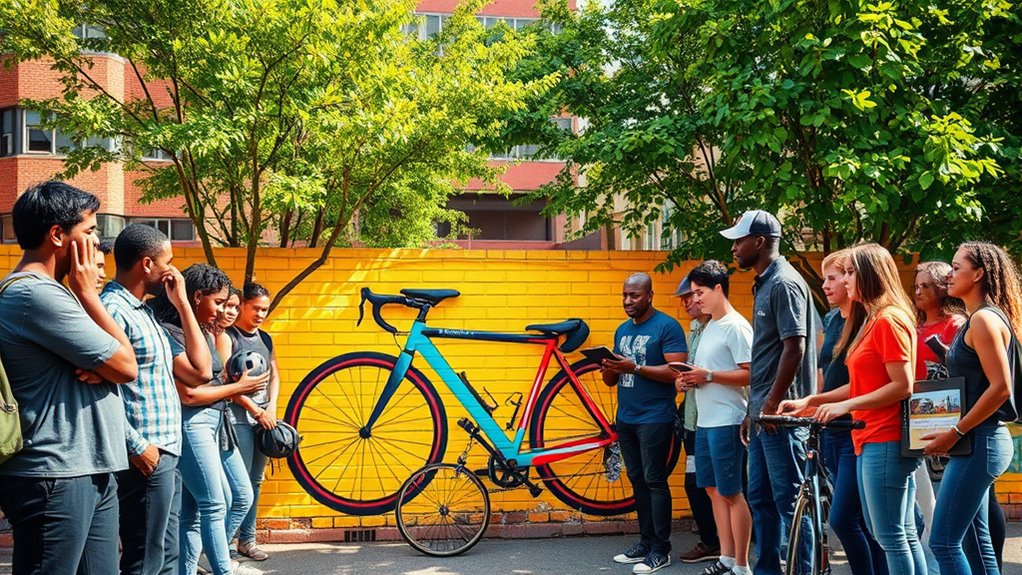
Building on the importance of data-driven strategies, empowering youth and neighborhood leaders strengthens cycling initiatives from the ground up.
Empowering youth and neighborhood leaders enhances cycling initiatives from the ground up.
You can support programs like Cadence Cycling Foundation or Connecticut Cycling Advancement Program, which inspire youth through education and skill-building.
Engaging local leaders through organizations like Bike Walk Golden or Yield to Life helps guarantee cycling efforts reflect community needs.
Providing advocacy training to neighborhood leaders boosts their ability to promote safe, accessible cycling spaces.
By fostering partnerships with schools, community groups, and local businesses, you create a network that sustains momentum.
Encouraging volunteer involvement and securing funding further solidify these initiatives.
When youth and neighborhood leaders are empowered, your community becomes a stronger advocate for safer, more inclusive cycling environments.
Frequently Asked Questions
How Can I Start a Local Bicycle Advocacy Group From Scratch?
To start a local bicycle advocacy group from scratch, you first gather interest by reaching out to bike shops, community centers, and online forums.
Then, define your group’s purpose and organize an initial meeting to align on goals.
Engage the community with rides or events, develop clear objectives, and create a structure with roles.
Seek sponsorships and form partnerships to build momentum, ensuring your efforts promote safer, more bike-friendly infrastructure.
What Are Effective Strategies to Engage Reluctant Community Members?
You want to engage reluctant community members, so start by organizing accessible, themed rides that appeal to diverse interests and skill levels.
Use social media and word-of-mouth to promote these events, emphasizing fun and community bonding.
Involve local businesses and leaders to boost credibility, and incorporate cultural or family-friendly activities.
Building relationships gradually helps break down barriers, making people more comfortable and enthusiastic to join your cycling initiatives.
How Do I Measure the Success of Cycling Advocacy Efforts?
Imagine your advocacy efforts are planting seeds in a garden. To measure success, track quantitative data like increased bike trips, safety improvements, and funding secured.
Collect community feedback to gauge safety and accessibility.
Use demographic data to see if marginalized groups are participating equally.
Celebrate milestones like new bike lanes or policies.
Combining these metrics helps you see your garden flourish, showing your efforts are making a real difference in community cycling.
What Funding Sources Are Available for Cycling Infrastructure Projects?
You can tap into various funding sources for cycling infrastructure projects. Federal programs like the Infrastructure Investment and Jobs Act and FHWA funds support bike lanes, trails, and bike racks.
State funding pools, transportation grants, and even gas tax revenues may be available.
Local options include municipal bonds, sales taxes, impact fees, and public-private partnerships.
Additionally, explore foundation grants, corporate sponsorships, crowdfunding, and non-profit partnerships to fund your bike projects.
How Can Youth Involvement Influence Local Transportation Policies?
You can influence local transportation policies by sharing your lived experiences through youth-led needs assessments, town halls, and surveys. Your feedback highlights safety concerns and route hazards, prompting policymakers to prioritize infrastructure upgrades.
Building leadership through mentorship, workshops, and partnerships helps you advocate effectively. When you suggest design changes and safety measures, you directly shape policies that improve safety, equity, and transit options for your community.
Conclusion
Getting involved in local cycling advocacy is a powerful way to make a difference in your community. By building trust, connecting with groups, and supporting policies, you can create safer, more bike-friendly streets. Using data and empowering others amplifies your impact. So, why not step up and be part of the change? Your voice and actions can inspire others to hop on board, making cycling accessible and enjoyable for everyone. Are you ready to get started?



